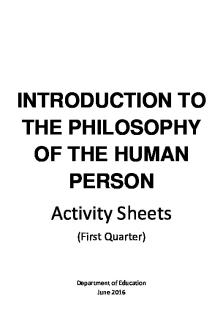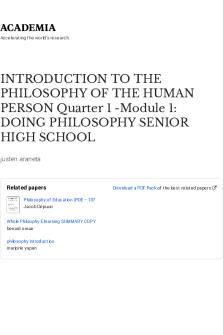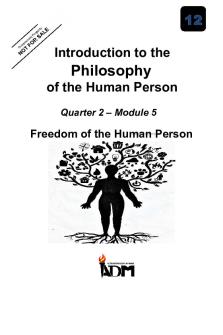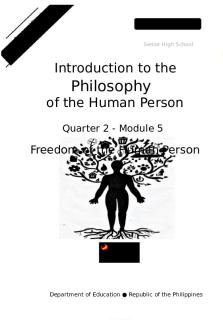Introduction to Philosophy of the Human Person Quarter 2 – Module 3: Human Person and Society PDF

| Title | Introduction to Philosophy of the Human Person Quarter 2 – Module 3: Human Person and Society |
|---|---|
| Author | John Nicholas Tabada |
| Course | Physics |
| Institution | Philippine Science High School System |
| Pages | 26 |
| File Size | 1.2 MB |
| File Type | |
| Total Downloads | 471 |
| Total Views | 1,045 |
Summary
Introduction toPhilosophy of theHuman PersonQuarter 2 – Module 3:Human Person and SocietyPersonal Development Alternative Delivery Mode Quarter 2 – Module 3: Title First Edition, 2020Republic Act 8293, section 176 states that: No copyright shall subsist in any work of the Government of the Philippin...
Description
Introduction to Philosophy of the Human Person Quarter 2 – Module 3: Human Person and Society
Personal Development Alternative Delivery Mode Quarter 2 – Module 3: Title First Edition, 2020 Republic Act 8293, section 176 states that: No copyright shall subsist in any work of the Government of the Philippines. However, prior approval of the government agency or office wherein the work is created shall be necessary for exploitation of such work for profit. Such agency or office may, among other things, impose as a condition the payment of royalties. Borrowed materials (i.e., songs, stories, poems, pictures, photos, brand names, trademarks, etc.) included in this module are owned by their respective copyright holders. Every effort has been exerted to locate and seek permission to use these materials from their respective copyright owners. The publisher and authors do not represent nor claim ownership over them. Published by the Department of Education Secretary: Leonor Magtolis Briones Undersecretary: Diosdado M. San Antonio Development Team of the Module Writers:
Mark Earvin M. Cervantes Urayjan M. Borlaza
Reviewers:
Cristeta M. Arcos Dolorosa S. De Castro
Illustrator:
Ronan DC. Vergara
Layout Artist:
Ren Mac Mac G. Motas
Management Team: Wilfredo E. Cabral, Regional Director Job S. Zape Jr., CLMD Chief Elaine T. Balaogan, Regional ADM Coordinator Fe M. Ong-ongowan, Regional Librarian Susan DL. Oribiana, SDS Dolorosa S. De Castro, CID Chief Cristeta M. Arcos, EPS In Charge of LRMS
Printed in the Philippines by ________________________ Department of Education – Region IV-A CALABARZON Office Address: Telefax: E-mail Address:
Gate 2 Karangalan Village, Barangay San Isidro Cainta, Rizal 1800 02-8682-5773/8684-4914/8647-7487 [email protected]
Introduction to Philosophy of the Human Person Quarter 2 – Module 3: Human Person and Society
Introductory Message For the facilitator: Welcome to the Introduction to Philosophy of the Human Person Alternative Delivery Mode (ADM) Module on Freedom and Responsibility! This module was collaboratively designed, developed and reviewed by educators both from public and private institutions to assist you, the teacher or facilitator in helping the learners meet the standards set by the K to 12 Curriculum while overcoming their personal, social, and economic constraints in schooling. This learning resource hopes to engage the learners into guided and independent learning activities at their own pace and time. Furthermore, this also aims to help learners acquire the needed 21st century skills while taking into consideration their needs and circumstances. In addition to the material in the main text, you will also see this box in the body of the module:
Notes to the Teacher This contains helpful tips or strategies that will help you in guiding the learners.
As a facilitator you are expected to orient the learners on how to use this module. You also need to keep track of the learners' progress while allowing them to manage their own learning. Furthermore, you are expected to encourage and assist the learners as they do the tasks included in the module.
ii
For the learner: Welcome to the Introduction to Philosophy of the Human Person Alternative Delivery Mode (ADM) Module on Freedom and Responsibility ! The hand is one of the most symbolized part of the human body. It is often used to depict skill, action and purpose. Through our hands we may learn, create and accomplish. Hence, the hand in this learning resource signifies that you as a learner is capable and empowered to successfully achieve the relevant competencies and skills at your own pace and time. Your academic success lies in your own hands! This module was designed to provide you with fun and meaningful opportunities for guided and independent learning at your own pace and time. You will be enabled to process the contents of the learning resource while being an active learner. This module has the following parts and corresponding icons:
What I Need to Know
What I Know
What’s In
This will give you an idea of the skills or competencies you are expected to learn in the module. This part includes an activity that aims to check what you already know about the lesson to take. If you get all the answers correct (100% ), you may decide to skip this module. This is a brief drill or review to help you link the current lesson with the previous one.
What’s New
In this portion, the new lesson will be introduced to you in various ways such as a story, a song, a poem, a problem opener, an activity or a situation.
What is It
This section provides a brief discussion of the lesson. This aims to help you discover and understand new concepts and skills.
What’s More
This comprises activities for independent practice to solidify your understanding and skills of the topic. You may check the answers to the exercises using the Answer Key at the end of the module.
What I Have Learned
This includes questions or blank sentence/paragraph to be filled in to process what you learned from the lesson.
What I Can Do
This section provides an activity which will help you transfer your new knowledge or skill into real life situations or concerns.
ii
Assessment
This is a task which aims to evaluate your level of mastery in achieving the learning competency.
Additional Activities
In this portion, another activity will be given to you to enrich your knowledge or skill of the lesson learned. This also tends retention of learned concepts.
Answer Key
This contains answers to all activities in the module.
At the end of this module you will also find: References
This is a list of all sources used in developing this module.
The following are some reminders in using this module: 1. Use the module with care. Do not put unnecessary mark/s on any part of the module. Use a separate sheet of paper in answering the exercises. 2. Don’t forget to answer What I Know before moving on to the other activities included in the module. 3. Read the instruction carefully before doing each task. 4. Observe honesty and integrity in doing the tasks and checking your answers. 5. Finish the task at hand before proceeding to the next. 6. Return this module to your teacher/facilitator once you are through with it.
If you encounter any difficulty in answering the tasks in this module, do not hesitate to consult your teacher or facilitator. Always bear in mind that you are not alone. We hope that through this material, you will experience meaningful learning and gain deep understanding of the relevant competencies. You can do it!
ii
What I Need to Know
Men -- by their nature – are political animals. This ancient saying of Aristotle has never lose its appeal. Perhaps the reason is that despite the long course it traversed in the history, it still capsulizes one of the essential elements of human nature – human’s endowed innateness to gather themselves and create a community where they share their commonalities and fix differences. In this module, learners will understand how individuals form societies and, in turn, how does society transform them. Importantly, learners will be able to explain how human relations are transformed by social systems. This module was designed and written with you in mind. It is here to help you master the different philosophical concepts of about human freedom, and thereafter examine the its relationship with responsibility. The scope of this module permits it to be used in many different learning situations. The language used recognizes the diverse vocabulary level of students. The lessons are arranged to follow the standard sequence of the course. But the order in which you read them can be changed to correspond with the textbook you are now using. After going through this module, you are expected to: 1. 2. 3. 4.
identify the different types of society; differentiate their qualities; explain digital society and digital citizenship; identify the effects of being a member of digital society.
ii
What I Know Learning Task No 1. Before delving into the discussion, learners must fill out the table below about the things they have learned from society and their contributions to it:
Things you learned from society
How did you learn them?
Impact on you
How did you share them to the community?
Impact on Society
1. 2. 3. 4. 5.
Things you have contributed to society
1. 2. 3. 4. 5.
ii
What’s In Learning Task 1: Essay. Read the following situations below and answer the questions thereafter. In answering the questions try to appreciate the situations using the social norms you remember. Situation Number 1: A Very good friend of yours visits you and your family in your house. Your mother who was delighted by her presence cooks her best dish for your friend. Your friend loved the whole lunch that she kept complementing your mother for being such a good cook. At the end of her visit, she expresses her gratitude to the whole family. Before she leaves, she approaches your mother and asks, “how much do I pay you for the lunch you cooked for me? (Ariely, 2010)
Situation Number 2: You are going through a very rough time. You feel so down that you need some one to talk to, you send a text message to your friend asking her if she could come over to make you feel better. Your friend gives you a call then tells you she will be there in 20 minutes. You are so happy to see her; you gave her a big hug and then pour your heart out. After crying to her for 30 minutes, she gives comforting piece of advice. You finally say that you feel so much better. Your friend then says, “That’s good to know, now that we’re done, could we settle my expenses for this – 20 pesos for the phone call, 35 pesos for the tricycle ride going here, 20 pesos for the tissue paper your drew from my pocket and 500 pesos for the time I lost to working productivity because I had to come here. Thanks!”
Questions: 1. Is there something wrong with the friend’s response to your mother’s hospitality? 2. Is there something problematic about your friend asking for payment for her loving presence? 3. What makes these two reactions awkward for you? 4. By making a reference to the society where you belong, what is your initial response upon reading the situations?
ii
What’s New Learning Task 3: Picture Analysis: Learners must analyze the pictures below by answering the questions following each of them. In this instance, learners must presume the prevailing thinking and even priorities during those times and guess what makes them transformed.
Picture No. 1: 1. What are the distinct features of this society? 2. Do you think what are their priorities during this time? 3. By seeing the picture, what do you think are the norms they have? 4. What caused the transformation of this society?
Picture No. 2: 1. What are the distinct features of this society? 2. Do you think what are their priorities during this time? 3. By seeing the picture, what do you think are the norms they have? 4. What caused the transformation of this society?
ii
Picture No. 3: 1. What are the distinct features of this society? 2. Do you think what are their priorities during this time? 3. By seeing the picture, what do you think are the norms they have? 4. What caused the transformation of this society?
What is It A. Pre-Industrial Societies a. Tribal Society - the term “tribe” denotes a group of peoples living in a primitive setting under a leader or chief. The term ‘tribal society’ associates it to other meaning such as “primitive society” or “preliterate society.” The word ‘tribe’ has become an important technical term which pertains to a political unit in a certain territory. The term’s use is rooted from Latin which is associated to the political divisions or orders of the Roman empire. Tribal societies are small in scale; bound to their spatial and temporal range of relations in terms of society, law, and politics; and possess a moral code, cult, and wide range of belief system. The language systems of tribes are unwritten which provides a narrow extent of communication. At the same time, tribal societies show a self-sustaining structure which is absent in the modern society. This is achieved by the close connections that exist between tribal organizations, and by the focusing of a leader or person to multiple roles. Unity and coherence exist in tribal values that are closely related to social groups and are provided with an intensity characteristic of all “closed” systems of thought. b. Feudal Society - Feudalism refers to the economic, political, and social system that prevailed in Europe from about the ninth to the fifteenth century. Due to the lack of effective centralized government during this period, kings and lords granted land and provided protection to lesser nobles known as vassals. In return, these vassals swore oaths of loyalty
ii
and military service to their lords. Peasants known as serfs were bound to the land and were subject to the will of their lords. One social class system or economic form was not realized for Europe over the whole Middle Ages. A new economy after medieval period known as capitalism is still in progress. Medieval world is known for its traditional land economy and military service, and an urban society. These led to a feudal-based social-class system and trade & commerce based on money or capital. For the urban or town environment, merchants, artisans, and customers formed the core of the society. They saw manufacture as the most important business to produce goods for sale and buy in the local market economy. Local products was to have an impact in other areas, such as regional fairs, port cities, and far trade destinations. B. Industrial society is the one which uses advance technology to drive a masssive production industry that will support a large population. For example, the United States is an industrial society because a huge portion of its economy is tied to jobs that involve machine work, like factory farming or auto-assembly plants, that has a combination of machine and human employees to produce goods. The objective of an industrial economy is the fast and efficient manufacturing of standardized products. The same goes if one avails a car, there is a chance that the car was mass produced because it operates similarly to other models, and its parts can be replaced with other parts because they are identical. C. Post Industrial Society - is marked by a progress from a manufacturing-based to a service-based economy. Post industrialization is most evident in countries and regions that were among the first to experience the Industrial Revolution, such as the United States, western Europe, and Japan. Daniel Bell, an American sociologist, first coined the term ‘post-industrial’ in 1973 in his book “The Coming of Post-Industrial Society: A Venture in Social Forecasting,” which describes several features of this kind of society. Post-industrial societies are characterized by:
a. a shift from the production of goods to the production of services; b. the replacement of manual laborers with technical and professional workers (computer engineers, doctors, and bankers) as the direct production of goods is moved elsewhere; c. the replacement of practical knowledge with theoretical knowledge; d. focusing to the theoretical and ethical implications of new technologies, which helps society avoid some of the negative
ii
features of introducing new technologies, concerning environment and energy; e. the development of recent scientific disciplines—that involve new forms of information technology, cybernetics, or artificial intelligence—to evaluate the theoretical and ethical implications of new technologies; f. an emphasis on the university and polytechnic institutes which produce graduates who innovate and lead the new technologies contributing to a postindustrial society; and g. the changing values and norms which reflects the influences on the society. In an instance, outsourcing of manufactured goods changes how members of a society see and treat foreigners and immigrants. Also, those individuals previously occupied in the manufacturing sector find themselves with no clearly defined social role.
DIGITAL SOCIETY AND THE INFORMATION AGE Digital technologies have wildly affected our interactions and activity in the 21st century. They have significantly changed our way of learning, working and socializing. In this modern world we rely with the use of modern technology which has led to considering the possible outcome for the society, concerning how we would take part in interaction, and how we can use these digital tools and communication channels. Having our heads of digital society in our minds, we first have to think of the information society; which are correlated with the progress and development of digital information and communication technologies to the internet at least. Information society plays a vital role with regards to the circulation and control of made-up ideas which affects political, economic, social and cultural aspects. So, what does this mean for the everyday citizen? These informative societies have paved many opportunities reaching bigger audiences like never before. With a wider scale of the world’s demography, primarily Westerners, have access to sources and technologies which enables them to connect with enough activities whether economic, social, political, or educational. We can manipulate the phasing of learning (e.g. free sources) or businesses (e.g. online selling) without a large sum of money used as a capital and we can share our ideas and perspectives to the international audiences as we connect beyond. What do we mean by digital citizenship? Now, one of the main terms in the modern world is the ‘digital citizen’. What does this actually mean? A digital citizen is a person who is knowledgeable and responsible enough to effectively use different social platforms in the internet. They often engage in useful topics and issues that will help build a better society, politics and government. If we will dig deeper, digital citizenship might look simple. We might think that it is just about using the internet safely. However, we also need to consider and understand that
ii
this citizenship can get complicated, especially if we are going to criticize and show interest in sensitive topics as we start to become a digital citizen, using digital media to actively participate in society and politics. If we look a little closer at the field of ‘citizenship studies’ this will lead us to a better understanding of what digital society really means. A citizen is defined as an individual character who is viewed as a member of a society while citizenship considers an individual’s behavior in terms of rights, obligations and functions of said citizen. Being a citizen of a state requires tons of obligations and duties such as work, taxation and obedience of laws. On the other hand, citizens also have their rights, it includes civil rights such as freedom of speech and expression, to stand for what we believe in, and rights to a private life; political rights, or the right to vote and social rights to health care and welfare. In this course we will tackle these rights as we look at real definition of what it means to be a citizen in the modern society and how legislation and the government shape our ability to be democratic citizens who can stand for the truth.
What does this all mean then in the digital age? We have said ...
Similar Free PDFs

The Human Person in Society
- 12 Pages

Human Person and Values Development
- 10 Pages

Introduction to the Human Body
- 9 Pages
Popular Institutions
- Tinajero National High School - Annex
- Politeknik Caltex Riau
- Yokohama City University
- SGT University
- University of Al-Qadisiyah
- Divine Word College of Vigan
- Techniek College Rotterdam
- Universidade de Santiago
- Universiti Teknologi MARA Cawangan Johor Kampus Pasir Gudang
- Poltekkes Kemenkes Yogyakarta
- Baguio City National High School
- Colegio san marcos
- preparatoria uno
- Centro de Bachillerato Tecnológico Industrial y de Servicios No. 107
- Dalian Maritime University
- Quang Trung Secondary School
- Colegio Tecnológico en Informática
- Corporación Regional de Educación Superior
- Grupo CEDVA
- Dar Al Uloom University
- Centro de Estudios Preuniversitarios de la Universidad Nacional de Ingeniería
- 上智大学
- Aakash International School, Nuna Majara
- San Felipe Neri Catholic School
- Kang Chiao International School - New Taipei City
- Misamis Occidental National High School
- Institución Educativa Escuela Normal Juan Ladrilleros
- Kolehiyo ng Pantukan
- Batanes State College
- Instituto Continental
- Sekolah Menengah Kejuruan Kesehatan Kaltara (Tarakan)
- Colegio de La Inmaculada Concepcion - Cebu












